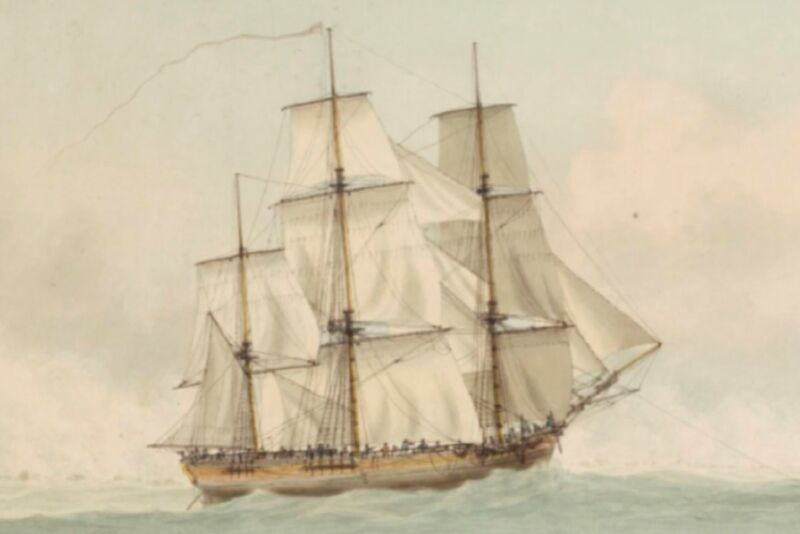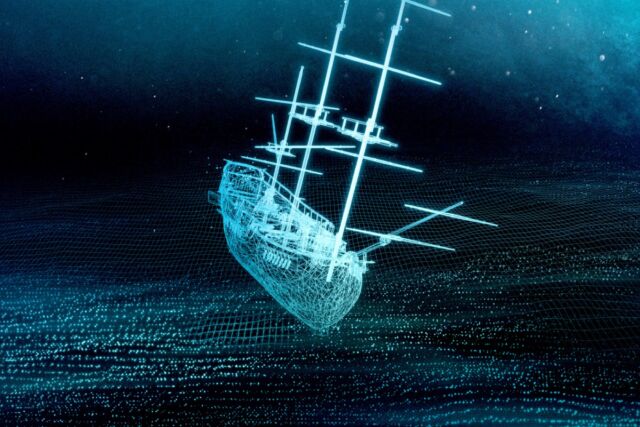Controversy erupts over Aussie museum’s identification of HMS Endeavour wreck
"Based on archival and archaeological evidence, I'm convinced it's the Endeavour."
JENNIFER OUELLETTE - 2/3/2022

Enlarge / Painting by Samuel Atkins of the HMS Endeavour off the coast of New Holland during Cook's voyage of discovery (1768-1771).
The HMS Endeavour is famous for being sailed by Capt. James Cook to the South Pacific for a scientific expedition in the late 18th century. But the Endeavour (by then renamed the Lord Sandwich) met its demise in the Atlantic, when it was one of 13 ships the British deliberately sank (or "scuttled") in a Rhode Island harbor during the American Revolution.
Now, the Australian National Maritime Museum has announced that its researchers have confirmed that a shipwreck proposed as a likely candidate in 2018 is indeed the remains of the HMS Endeavour. However, the Rhode Island Marine Archaeology Project (RIMAP)—the museum's research partner in the project—promptly released a statement calling the announcement premature. RIMAP insists that more evidence is needed and that its own final report is still forthcoming.
The HMS Endeavour holds special relevance for the scientific community because Cook's first voyage (1768-1771) was, in part, a mission to observe and record the 1769 transit of Venus across the Sun. The observation was part of a combined global effort to determine the distance of the Earth from the Sun. Those observations proved less conclusive than had been hoped, but during the rest of the voyage, Cook was able to map the coastland of New Zealand before sailing west to the southeastern coast of Australia—the first record of Europeans on the continent's Eastern coastline.
FURTHER READING Captain Cook’s HMS Endeavour found off the coast of Rhode Island
But back to the Atlantic. As Ars' Kiona Smith reported, archaeologists and divers in 1993 consulted 18th-century maps and logs for information about the locations of the wrecks of the Endeavour (now the Lord Sandwich) and the other ships scuttled with it. Then the researchers took to the water with side-scan sonar to find the remains.Advertisement
Kiona continued:
It was painstaking work, especially in the early years before GPS technology was available to help with precise mapping. Every possible shipwreck that turned up in the sonar images had to be checked by divers, a process archaeologists call "ground-truthing." Some of those sites turned out to be modern vessels, lumpy geological formations, piles of abandoned commercial fishing tackle, and even Navy training torpedoes...
By 2016, RIMAP's volunteers, operating on grants and private donations, had located 10 of the 13 wrecks, almost exactly where historical charts said they should be. And the search had gotten a boost from the 1998 discovery of a 200-year-old paper trail linking the troop transport Lord Sandwich to its former life as HMS Endeavour.
But which of those wrecks was the Endeavour? One candidate was found just 500 meters off the coast of Rhode Island, 14 meters below the surface and buried in nearly 250 years' worth of sediment and silt. RIMAP's team concluded in 2018 that this was likely the wreck of the Endeavour, although the researchers emphasized that they needed to accumulate more evidence to support their conclusions.

Enlarge / A digital remodeling of the ship, which was scuttled in 1778.
Australian National Maritime Museum
That's because only about 15 percent of the ship survives. Any parts of the hull that weren't quickly buried by silt have long since decomposed in the water. Initially, all that appeared to be left were the piles of ballast (heavy stones placed in the bottom of a ship's hold to help keep it stable when empty) visible on the harbor bottom. But archaeologists have since found ceramic teapots, glass bottles, lead pieces from pumps, and bits of rope encased in concrete-like substances produced by corroding metal, all buried beneath the harbor's silt amid the waterlogged timbers.Advertisement
The Australian National Maritime Museum held a press conference to announce its conclusion. The museum said its researchers matched structural details and the shape of the remains to those on original plans of the Endeavour—including the size of the timbers and the scuttling holes in the keel. The remains are also European-built, the museum said.
"The last pieces of the puzzle had to be confirmed before I felt able to make this call," Kevin Sumption, director of the museum, said. "Based on archival and archaeological evidence, I'm convinced it's the Endeavour."
RIMAP executive director DK Abbass issued the following statement soon afterward:
The Australian National Maritime Museum (ANMM) report that the Endeavour has been identified is premature. The Rhode Island Marine Archaeology Project (RIMAP) is now and always has been the lead organization for the study in Newport harbor. The ANMM announcement today is a breach of the contract between RIMAP and the ANMM for the conduct of this research and how its results are to be shared with the public. What we see on the shipwreck site under study is consistent with what might be expected of the Endeavour, but there has been no indisputable data found to prove the site is that iconic vessel, and there are many unanswered questions that could overturn such an identification. When the study is done, RIMAP will post the legitimate report on its website at: www.rimap.org. Meanwhile, RIMAP recognizes the connection between Australian citizens of British descent and the Endeavour, but RIMAP's conclusions will be driven by proper scientific process and not Australian emotions or politics.
"We are very open to conversations with Dr. Abbass if she disagrees with our findings, their findings," Kieran Hosty, the ANMM's manager of maritime archeology, told the Australian Broadcasting Corporation (ABC). He added that he believed their contract with RIMAP had ended in November, although he could not be sure.
JENNIFER OUELLETTE is a senior writer at Ars Technica with a particular focus on where science meets culture, covering everything from physics and related interdisciplinary topics to her favorite films and TV series. Jennifer lives in Los Angeles.
No comments:
Post a Comment